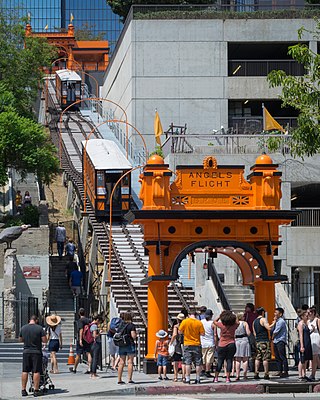
Angels Flight is a landmark and historic 2 ft 6 in narrow gauge funicular railway in the Bunker Hill district of Downtown Los Angeles, California. It has two funicular cars, named Olivet and Sinai, that run in opposite directions on a shared cable. The tracks cover a distance of 298 feet (91 m) over a vertical gain of 96 feet (29 m).

Olvera Street, commonly known by its Spanish name Calle Olvera, is a historic pedestrian street in El Pueblo de Los Ángeles, the historic center of Los Angeles. The street is located off of the Plaza de Los Ángeles, the oldest plaza in California, which served as the center of the city life through the Spanish and Mexican eras into the early American era, following the Conquest of California.

The Ávila Adobe, built in 1818 by Francisco Ávila, is the oldest standing residence in the city of Los Angeles, California. Avila Adobe is located in the paseo of historic Olvera Street, a part of the Los Angeles Plaza Historic District, a California State Historic Park. The building itself is registered as California Historical Landmark #145, while the entire historic district is listed both on the National Register of Historic Places and as a Los Angeles Historic-Cultural Monument.

The Civic Center neighborhood of Los Angeles, California, is the administrative core of the City of Los Angeles, County of Los Angeles, and a complex of city, county, state, and federal government offices, buildings, and courthouses. It is located on the site of the former business district of the city during the 1880s and 1890s, since mostly-demolished.
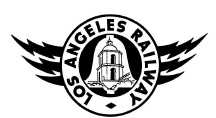
The Los Angeles Railway was a system of streetcars that operated in Central Los Angeles and surrounding neighborhoods between 1895 and 1963. The system provided frequent local services which complemented the Pacific Electric "Red Car" system's largely commuter-based interurban routes. The company carried many more passengers than the Red Cars, which served a larger and sparser area of Los Angeles.

The Zanja Madre is the original aqueduct that brought water to the Pueblo de Los Angeles from the Río Porciúncula. The original open, earthen ditch, or zanja was completed by community laborers within a month of founding the pueblo. This water system was used for both domestic uses and irrigation to fields west of town. The main zanja ultimately fed eight branch zanjas. This availability of water was essential to the survival and growth of the community founded here. Brick conduits 3 to 3.5 feet in diameter were built to improve the system after 1884. Eventually the system did not supply enough water to keep pace with population growth and irrigation demand. The system was abandoned by 1904 though portions were still used for storm water purposes. It was maintained by the Zanjero of Los Angeles.

Horton Plaza was a five-level outdoor shopping mall in downtown San Diego. It was designed by Jon Jerde and was known for its bright colors, architectural tricks, and odd spatial rhythms, occupying 6.5 city blocks adjacent to the city's historic Gaslamp Quarter. Opening in 1985, it was the first successful downtown retail center since the rise of suburban shopping centers decades earlier.
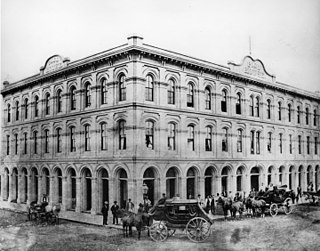
The Pico House is a historic building in Los Angeles, California, dating from its days as a small town in Southern California. Located on 430 North Main Street, it sits across the old Los Angeles Plaza from Olvera Street and El Pueblo de Los Ángeles Historical Monument.
Los Angeles Street, originally known as Calle de los Negros is a major thoroughfare in Downtown Los Angeles, California, dating back to the origins of the city as the Pueblo de Los Ángeles.

The Hollywood Subway, as it is most commonly known, officially the Belmont Tunnel, was a subway tunnel used by the interurban streetcars of the Pacific Electric Railway. It ran from its northwest entrance in today's Westlake district to the Subway Terminal Building, in the Historic Core, the business and commercial center of Los Angeles from around the 1910s through the 1950s. The Subway Terminal was one of the Pacific Electric Railway’s two main hubs, the other being the Pacific Electric Building at 6th and Main. Numerous lines proceeded from the San Fernando Valley, Glendale, Santa Monica and Hollywood into the tunnel in Westlake and traveled southeast under Crown and Bunker Hill towards the Subway Terminal.

Garbutt House is a 20-room mansion in the Silver Lake section of Los Angeles built from 1926 to 1928 as the residence of Frank A. Garbutt. It was listed in the National Register of Historic Places in 1987.

Watts Station is a train station built in 1904 in Watts, Los Angeles, California. It was one of the first buildings in Watts, and for many years, it was a major stop for the Pacific Electric Railway's "Red Car" service between Los Angeles and Long Beach. It was the only structure that remained intact when stores along 103rd Street in Watts were burned in the 1965 Watts Riots. Remaining untouched in the middle of the stretch of street that came to be known as "Charcoal Alley", the station became a symbol of continuity, hope, and renewal for the Watts community. It has since been declared a Los Angeles Historic-Cultural Monument and is listed on the National Register of Historic Places.

El Pueblo de Los Ángeles Historical Monument, also known as Los Angeles Plaza Historic District and formerly known as El Pueblo de Los Ángeles State Historic Park, is a historic district taking in the oldest section of Los Angeles, known for many years as El Pueblo de Nuestra Señora la Reina de los Ángeles del Río de Porciúncula. The district, centered on the old plaza, was the city's center under Spanish (1781–1821), Mexican (1821–1847), and United States rule through most of the 19th century. The 44-acre park area was designated a state historic monument in 1953 and listed on the National Register of Historic Places in 1972.
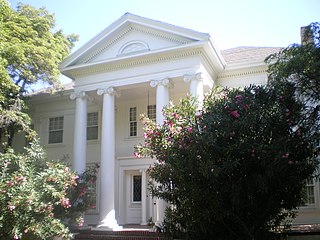
St. James Park is a neighborhood in the West Adams section of Los Angeles, California. It is a residential neighborhood surrounding St. James Park consisting of homes built in a mix of Classical Revival, Craftsman and Queen Anne styles. The neighborhood was added to the National Register of Historic Places in 1991 and contains eleven Historic-Cultural Monuments.
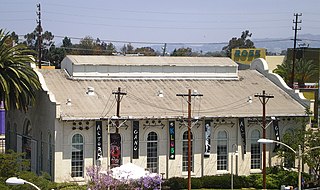
Ivy Substation is a 99-seat theatre in Culver City, California which formerly housed power equipment for the nearby electric railways and Ivy station. It was listed on the National Register of Historic Places in 1981.

LA Plaza de Cultura y Artes, also called LA Plaza is a Mexican-American museum and cultural center in Los Angeles, California, USA that opened in April 2011. The museum contains interactive exhibits designed by experience design expert Tali Krakowsky such as a reconstruction of a 1920s Main Street. The museum shares the stories of the history, cultures, values, and traditions of Mexicans, Mexican Americans, and all Latinos in Los Angeles and Southern California. The museum programs include exhibitions, educational programs, and public programming.
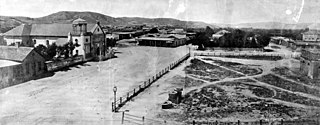
Los Angeles Plaza or Plaza de Los Ángeles is located in Los Angeles, California. It is the central point of the Los Angeles Plaza Historic District. When Spanish Governor Felipe de Neve founded the Pueblo de Los Ángeles, his first act was to locate a plaza for the geographical center from which his town should radiate. De Neve's plaza was rectangular in form—75 varas wide by 100 in length. It was located north of the church; its southerly line very nearly coincided with the northerly line of West Marchessault street. On this, the cuartel, the public granary, the government house and the capilla (chapel), fronted.

The Pacific Electric Sub-Station No. 14 is a former traction substation in Santa Ana, California. It was built by the Pacific Electric Railway to provide electricity to run the railway's streetcars in central Orange County, California. The building was added to the National Register of Historic Places in 1983.

The Venice Short Line was a Pacific Electric (PE) interurban railway line in Los Angeles which traveled from downtown Los Angeles to Venice, Ocean Park, and Santa Monica via Venice Boulevard. The route was especially busy on Sundays, as Venice was PE's most popular beachfront destination.
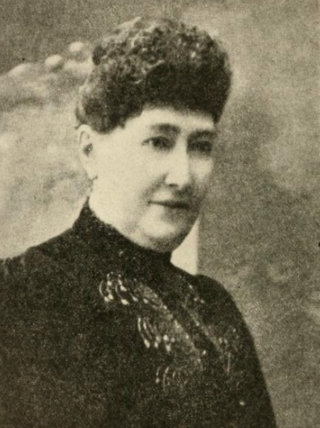
Doria Deighton-Jones was a Scottish-born American landowner and property developer in Los Angeles who built a "vast estate in and around" the city while the city was in its infancy.


























